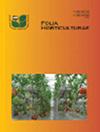外源谷氨酰胺对盐胁迫下洋葱萌芽、植株发育及一些胁迫相关基因转录表达的作用
IF 1.8
4区 农林科学
Q2 HORTICULTURE
引用次数: 0
摘要
本研究旨在探讨谷氨酰胺(Gln)在盐度[0、50、100、150、200 mM氯化钠(NaCl)]条件下对植物萌发和生长的作用,以及对一些胁迫相关基因[CuZn-超氧化物歧化酶(SOD)、Mn-SOD、替代氧化酶(AOX)、原胶原蛋白赖氨酰羟化酶(PLOD-1)、伴侣素(CHAPE)和热休克蛋白(HOX)]激活的作用、Mn-SOD、替代氧化酶(AOX)、胶原溶解羟化酶(PLOD)-1、伴侣素(CHAPE)和热休克蛋白(HSP)-21]、遗传模板稳定性和光合色素活化。在盐胁迫条件下,施用 2 mM Gln 可缩短平均发芽时间(MGT)(4.51 天),提高发芽速度系数(CVG)(75.85)、发芽指数(GI)(1.46)和发芽率(GP)(82%),表明它是胁迫条件下发芽的最佳施用方法。Gln 能促进植物地上器官的发育。在非胁迫和胁迫条件下,3 mM Gln 可使叶片数量分别从 5.3 片增加到 13.7 片和 4.3 片增加到 6.6 片。在盐胁迫条件下,Gln 增加了光合色素和基因组模板稳定性(GTS)(80%)。在 2 mM Gln 条件下,总叶绿素和类胡萝卜素含量分别从 1.59 mg - g-1 TA 增加到 2.23 mg - g-1 TA 和从 0.28 mg - g-1 TA 增加到 0.37 mg - g-1 TA。对基因表达水平的影响因浓度而异。施用 2 mM Gln 可提高胁迫下的发芽率和植株参数,但会导致 CuZn-SOD 基因表达量增加,而作为修复机制功能指标的 HSP-21 基因转录表达量减少 43%。经 Gln 处理的植物在胁迫下的生长情况有所改善,这表明 Gln 在胁迫下可作为代谢活动的替代燃料,参与弥补植物的能量不足。本文章由计算机程序翻译,如有差异,请以英文原文为准。
The role of exogenous glutamine on germination, plant development and transcriptional expression of some stress-related genes in onion under salt stress
The purpose of this research was to explore the role of glutamine (Gln) on plant germination and growth under salinity [0, 50, 100, 150, 200 mM sodium chloride (NaCl)], and on the activation of some stress-related genes [CuZn-Superoxide Dismutase (SOD), Mn-SOD, Alternative Oxidase (AOX), Procollagen Lysyl Hydroxylase (PLOD)-1, Chaperonin (CHAPE) and Heat Shock Protein (HSP)-21], genetic template stability and photosynthetic pigment activation. Under salt stress, 2 mM Gln application reduced the mean germination time (MGT) (4.51 days), increased the coefficient of velocity of germination (CVG) (75.85), germination index (GI) (1.46) and germination percentage (GP) (82%), indicating that it was the best application for germination under stress. Gln promoted the development of aboveground plant organs. 3 mM Gln increased the number of leaves from 5.3 to 13.7 and 4.3 to 6.6 under unstress and stress conditions, respectively. Under salt stress, Gln increased photosynthetic pigments and genomic template stability (GTS) (80%). At 2 mM Gln, total chlorophyll and carotenoid content increased from 1.59 mg · g-1 TA to 2.23 mg · g-1 TA and from 0.28 mg · g-1 TA to 0.37 mg · g-1 TA, respectively. The effect on gene expression levels varied with the concentration. The application of 2 mM Gln, which enhanced germination and vegetative parameters under stress, caused a raise in CuZn-SOD gene expression and a 43% decrease in the transcriptional expression of the HSP-21 gene as an indicator of the functionality of the repair mechanism. The improved growth of Gln-treated plants under stress suggests that Gln is involved in bridging the energy deficit of the plant by acting as an alternative fuel for metabolic activities under stress.
求助全文
通过发布文献求助,成功后即可免费获取论文全文。
去求助
来源期刊

Folia Horticulturae
Agricultural and Biological Sciences-Horticulture
CiteScore
3.40
自引率
0.00%
发文量
13
审稿时长
16 weeks
期刊介绍:
Folia Horticulturae is an international, scientific journal published in English. It covers a broad research spectrum of aspects related to horticultural science that are of interest to a wide scientific community and have an impact on progress in both basic and applied research carried out with the use of horticultural crops and their products. The journal’s aim is to disseminate recent findings and serve as a forum for presenting views as well as for discussing important problems and prospects of modern horticulture, particularly in relation to sustainable production of high yield and quality of horticultural products, including their impact on human health.
 求助内容:
求助内容: 应助结果提醒方式:
应助结果提醒方式:


